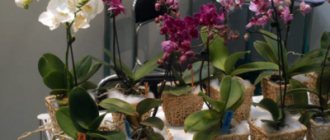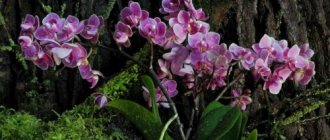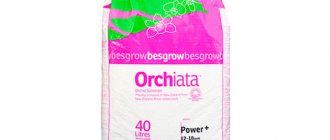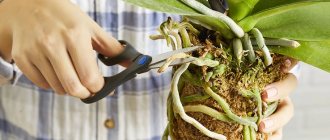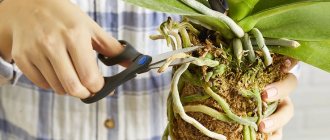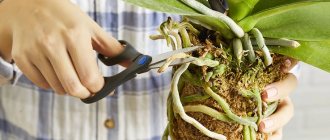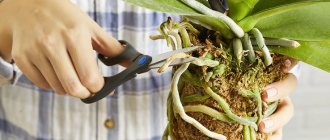Despite all their external exoticism and non-triviality, orchids cannot be called picky plants : with the proper level of theoretical awareness of the conditions in which an orchid prefers to grow and bloom, achieving lush, bright flowering of this flower is not so difficult.
One of the most difficult aspects of growing orchids is choosing the right substrate.
One of its popular varieties is coconut fiber .
Coconut substrate has begun to enjoy great popularity among amateur gardeners.
Is it worth considering how suitable this substrate is for growing orchids at home? It is worth considering in more detail and learning more about coconut substrate (chips, fiber) for orchids. We will deal with this issue further.
Coconut chips
They are crushed coconut shells. The product is porous, fibrous, breathable, with an optimal pH of 5.5-6, and contains a sufficient amount of nutrients.
Due to its increased moisture capacity, it is used in combination with baking powder.
Used for growing young plants and terrestrial orchids. For adult epiphytic orchids, larger pieces of coconut are suitable.
Coconut chips: benefits and harms
Benefits of coconut substrate:
pH balanced environment. Fiber contains everything in the required quantities, so there is no need to adjust the acidity level.
Good breathability. Coconut provides an optimal ratio of air and water in the root system. The chips have a porous surface, which actively saturates the roots with oxygen.
Ability to accumulate moisture. The slices have a sponge-like structure that is capable of holding an amount of water five times the weight of the chips themselves. This quality makes them healthier than the famous mineral wool. Even after complete drying, the substrate is able to absorb water again.
Pregnancy of the material. You no longer have to waste time and money trying to get rid of pests. Orchids will hurt less and bloom longer. And all this thanks to coconut chips, which are pest-free.
They are able to accumulate minerals when they are in excess, and then use the “reserves” in dry and unfavorable conditions.
Reusable. A special substance - Lignite - allows coconut to remain unchanged for a long period of time. The shavings do not rot or deform, which makes them a unique substrate.
There are no downsides to coconut chips. The only problem is choosing the right one. You can run into unscrupulous sellers and buy low-quality chips.
Substrate
Substrate is an artificial nutrient medium. Substrate from lat. substratum "substrate, litter". The main task is to supply the plant with nutrients.
A properly selected substrate is 60-80% of success in growing orchids.
For epiphytic orchids, the main ingredient is pine bark, which makes the substrate light, loose, and does not retain moisture.
Ground orchids require a slightly different substrate. For them, the humidity should be an order of magnitude higher and the substrate denser.
The basis of the substrate for terrestrial orchid species can be the same as for epiphytic forms. In addition to the bark, it is necessary to add peat, which will help the orchid to constantly have a sufficient amount of moisture, as well as sphagnum moss.
Where can I get sphagnum moss?
I'll start by explaining what it is. Sphagnum moss is white or greenish shoots that grow tall (like an orchid). Moss grows in a swamp. There is no need to look for a swamp. You can go to a lake or other body of water. Sphagnum moss also loves damp places. Sphagnum moss usually grows above the surface of the water. This moss needs to be cut off, washed under running water and boiled for 5 minutes. Let it dry. The orchid needs sphagnum as a sponge. It absorbs moisture and then gives it to the orchid.
There is another option: purchase a “natural sponge” in a specialized store or order it online.
Sphagnum moss for orchids
pine bark
Pine bark is best boiled for at least 16 hours, 2-3 cm in size.
The problem with fresh bark is that it does not take up moisture, water flows down it and does not linger.
If the bark is not boiled, it does not absorb and retain moisture well. Therefore, you need to add chopped sphagnum moss (30% by volume).
Do-it-yourself bark preparation
If you are harvesting the bark yourself, then the bark 2-4 cm thick should be removed from a dry pine tree that is still standing, but not from rotten trees.
You need to make sure that part of the wood - bast fibers - does not get in with the bark.
The bark is cut into pieces with pruning shears.
How and why to cook the bark?
It is boiled in order to boil down the resin and it begins to take on water.
In the evening, pour the bark into pieces into a saucepan, add water, cover with a lid and let it boil. As soon as the water boils, turn off the gas and leave until the morning.
During the night the bark gets wet and sinks. In the morning, turn on the gas and, when the water boils, cook for 8-10 hours.
On the second day in the morning, drain the black broth, add fresh water and cook for another 8-10 hours. Once the water has cooled, rinse the bark in clean water.
Then dry. Be sure to dry completely. If you don't dry it completely, mold is guaranteed.
Cooking the bark for less than 10 hours does not give the desired effect.
If there is no possibility or desire to cook, then you can add 20-30% chopped sphagnum moss or coconut chips to the bark.
There is no need to add anything to the boiled bark.
Products from popular manufacturers
Orchiata
Orchiata bark is the best bark available.
Coarse bark 18-25 mm is suitable for use both for adult orchids and in a mixture with moss for teenagers.
Orchiata is a substrate made from a granulated layer of radiata pine bark (lat. Pínus radiata) produced in New Zealand. It doesn’t harden for a long time and doesn’t hurt. Disinfected.
You can read more about Orchiata in the following article.
Substrate Morris Green, Russian production
The manufacturer offers coarse-grained dried pine bark, without crushing, suitable for planting adult orchids in substrate and on blocks. The material is clean and treated against parasites.
BIO EFFECT
Another domestic product. Complex substrate based on Angara pine bark. Dolomite flour was added to reduce the acidity of the material. Dried, treated against harmful insects.
How to make Orchiata bark
After boiling and washing, before drying, mix the bark with clean acidic peat. Approximately a liter of peat for 1 bucket of bark and dry completely. Store in a bag in a dry place.
When soaked before planting, the peat will be washed off and there will be clean, moisture-absorbing, biologically active (with the necessary fungi and bacteria to prevent mold) bark.
Important! Before use, any bark should be soaked for 4-5 hours, drowned in water at room temperature so that it is well saturated with water.
High peat
An excellent component for orchids is high-fiber peat. You just can’t use such peat right away. It needs to be kept in the open air for at least a year, let it be washed by rain, melt water and let harmful swamp gases disappear from it. You can also buy high peat at a flower shop. The purchased cake can be used immediately.
If there is any doubt about the type of peat, it is better to check its acidity with a pH meter or indicator paper. Peat can be very acidic with a pH of 3-3.5, such as high-moor peat, neutral peat with a pH of 6.5, and low-lying peat. There is peat with an intermediate value.
To plant orchids, you can use ready-made peat blocks where the pH is neutral. In such blocks, high acidity is extinguished by dolomite flour. For the usual 1 kg of moderately moist high-moor peat, take 5 g of this flour.
Orchid substrate with peat should be treated carefully. It is moisture-intensive, but with severe waterlogging it can lose air permeability, which can lead to rotting of the roots. Low in nutrition, but holds excess salts well. At the same time, it dries out easily, and the accumulated salts begin to “dry out” the roots of the plant.
On a note!!!
Peat, unlike sphagnum, after drying, literally repels water and floats when the root ball is soaked.
Pieces of the fraction from 1 to 3 cm without dusty inclusions are suitable for preparing the substrate. Peat is usually added to the substrate for large terrestrial orchids to increase the moisture holding capacity of the substrate.
Planting and subsequent care
Planting an orchid in the bark follows the basic rules for planting epiphytes. This material is considered one of the best substrates for most epiphytes and lithophytes. The pieces should be:
- Suitable size;
- Clean;
- And disinfected.
Therefore, the orchid requires proper care.
How to fill a pot correctly?
Large pieces of bark can be used as an independent substrate. If desired, expanded clay or pieces of polystyrene foam can be placed on the bottom in a layer of 3–4 cm. The first 2–3 layers of bark should be large fragments. After this, the orchid roots are placed in the pot.
Technology
The roots should freely enter the container and be located above the lower layers of the laid substrate.
Holding the orchid suspended with one hand, pieces of bark are poured (placed) between the roots, periodically lightly tapping the pot on a horizontal surface, for example, on a table. Pour the bark up to the root collar without covering it.
Attachment methods
The orchid does not have to be planted in a substrate. From large pieces you can make a block on which to attach the orchid. For this:
- A little sphagnum moss is placed on the block;
- The orchid is pressed on top;
- Secure with soft thin wire or fishing line.
Watering
Watered using the immersion method. The container with the plant is placed in a large bowl of water. After 20–30 minutes, remove and allow the water to drain. After this, the orchid is returned to its permanent place.
The average frequency of watering is once every 7–10 days. Depending on the conditions, watering is increased or reduced. It is necessary to properly care for your orchid at home.
Coconut shell pots: growing features
Surprisingly, in Asia, orchids grow right on the streets in improvised coconut pots. Here you can also make an original flowerpot at home. When cutting, you should take into account not only the beauty of the pot.
There are a number of rules that should be taken into account in order for an orchid to feel comfortable in such an unusual pot. First of all, you need to drill more drainage holes. Five, six, or better yet, eight or nine. The holes should be placed evenly at the bottom, add a few on the sides.
This is necessary so that the orchid’s roots have access to oxygen and excess liquid drains. Also, when choosing coke for a pot, pay attention to its shape. The top should be wider than the bottom. This is necessary so that the roots are naturally distributed and the pot becomes more stable.
You can check whether you did everything correctly by pouring water into the resulting pot. If the excess does not stagnate and drains, then everything was done correctly and the flower will be comfortable in the new pot.
Coconut chips for orchids: how to use the fiber
For planting exotic plants, coconut peat is used, which is a type of nut substrate. Coconut chips are also used for orchids and other decorative flowers.
How to use coconut chips for orchids
Coconut substrates
Coconut palm substrate is an organic medium intended for growing mushrooms, vegetables, berries, fruits and various crops, where the peel serves as a raw material. It consists of fibers with a length of 15 to 33 cm and coconut peat, which is a binder. When processing the peel, these components are separated. Substrates are made from peat.
The fiber is used to make ropes, brushes, mattresses, and rugs. Often this substance is an integral part of substrates. The compact compressed packaging of the fiber is called “Coconut Briquette”.
Another method of processing nut shells eliminates the extraction of fibers. In this case, it is cut into pieces of various sizes. The pieces, which contain peat and fiber, are called coconut chips. They are used as a supplement to substrates, including when growing exotic plants, including orchids.
Advantages of coconut chips
Special primer
Chips as a growing medium have a number of advantages:
- Elementary recycling. Plant growers almost always face the problem of disposing of mineral wool. Coconut chips, on the contrary, after application, can simply be buried in the soil and in this way used to improve its structure.
- Optimal pH. Coconut does not require additional acid regulation due to the pH level in the fiber suitable for most crops.
- Increased air capacity. The coconut fruit has the ability to provide optimal proportions of water and air in the root area. Only mineral wool has this ability, so these substrates are the undisputed leaders in use for hydroponics. An excess of moisture in mineral wool leads to an insufficient amount of air in the root part, which significantly inhibits its growth and development. Chips, on the contrary, saturate the rhizomes with the necessary oxygen even with excess water. This effect is a consequence of the high porosity of the fiber.
- Water-retaining properties. The sponge-like structure allows coconut chips to retain up to 5 times their own weight in moisture. In this parameter they are superior to peat and compete with mineral wool.
- Sterility. There are no harmful organisms in coconut substrate. This property will be appreciated by flower growers, who still have to use a variety of means to eliminate plant diseases and pest infestations.
- Hydrophilicity. Unlike its fellows, the nut is extremely water-loving. Dried chips easily absorb water again.
- Resistant to decomposition. The unique characteristics in coconut can persist for a long period. Lignin in its composition slows down all processes associated with decomposition. As a result, the chips are not deformed, air capacity and moisture capacity remain at the same level.
- Buffering. The chips can store nutrients and transfer them if there is insufficient supply to the orchids.
- High quality. The properties of the chips depend on the area where the coconut is grown and the method of processing the peel. Initially it is characterized by a high content of chlorine, sodium and potassium. Bringing the indicators back to normal is achieved by soaking the peel in fresh water. The longer this process, the less salts remain in the coconut. As a rule, soaking lasts several months.
Substrate Application
Coconut chips are thoroughly sterilized before use. Before planting orchids, the substrate is soaked and heated in boiled water. It should be at room temperature and placed in a kind of greenhouse (pots or special seedling cassettes).
The swollen substrate is thoroughly washed and then filtered using gauze or a tulle curtain. Rinsing in clean water should be done at least 10 times: this will eliminate the salts. Dried chips are ready for planting flowers.
In Asian countries, orchids are found planted in parts of coconuts nailed to trees.
COCONUT PEAT AND EXPANDED ITE – ORCHID TRANSPLANT! RESUSCIVATION OF ORCHIDS WITHOUT ROOTS, WITH ROTTEN ROOTS! #3What substrate is needed for planting orchids? COCONUT PEAT FOR GROWING SEEDLINGS, BUT NOT ORCHIDS!
Summarizing
Thanks to their advantages, coconut chips are the optimal substrate for growing orchids and a real boon for gardeners.
Fern roots
Previously, the roots of the osmuda fern were considered an ideal substrate for growing orchids; now the roots of the kochedednik, shield and bracken are used. Many orchidists grow especially rare and delicate species only in this substrate. It is also used for epiphytic blocks.
On a note!!!!
Tree fern fibers have characteristics similar to coconut fiber.
Fern roots are harvested in early autumn, when the leaves on the trees have already turned yellow. The root ball is shaken off with soil, then washed and dried. The root is cut into pieces of 2 to 3 cm. They are lightly soaked before use so that they do not crumble.
The substrate for orchids with the addition of fern roots is enriched with nutrients, it is moderately moisture-holding, has good air permeability and perfectly retains its structure. Able to not decompose for a long time.
Components used
Taking into account the recommendations of professional gardeners, it is not difficult to guess that the soil for exotics should be light, but at the same time very nutritious. What components does the finished substrate for an orchid consist of?
Charcoal
This component is considered the main regulator of soil acidity, the level of which constantly varies. Getting charcoal is not difficult. It’s enough to simply collect it after the fire. The best option is coal after burning birch
It is important to consider that there should be no flammable substances in the fire - chemicals are extremely harmful to plants
Swamp sphagnum moss
It is known that moss has a high moisture capacity, which determines its importance in the composition of the soil. However, it is worth considering that its amount should not exceed 15–20%, otherwise the risk of excessive soil moisture increases significantly. Sphagnum moss is often used. It can be found in any swampy area.
Before use, the material should be thoroughly dried and treated with insecticidal preparations. This will prevent your pet from becoming infected with all kinds of infections.
Sphagnum moss is used to grow exotic flowers.
Fern roots
Not all varieties of orchids love this component. For example, fern roots are definitely not suitable for phalaenopsis. But this material will be an excellent addition to the soil for cymbidium
Fern roots must be used with great care, as they are very nutritious. Nutritious soil, as a rule, is quite dense, which means it does not allow moisture to pass through easily. Not a single species of orchid can survive in such soil.
Not a single species of orchid will survive in such soil.
Fern roots can be obtained from the forest in early spring or late autumn. The roots are dug up, thoroughly dried and stored in a dark, dry place.
Pine bark
Considering the fact that in the wild orchids grow mainly on tree trunks, the benefits of the bark are undeniable. It is rightfully considered the basis of the substrate for exotics, because it makes up about 50% of the soil. Pine bark is most often used, but oak and poplar are also excellent for this purpose.
To collect bark, you need to find a dead tree
This is very important, since a tree that has been cut down long ago no longer contains resins.
Pine bark retains moisture well
Oak bark
It is characterized by the same properties as pine: it promotes uniform distribution of moisture in the substrate and increases the air permeability of the soil. If the bark of a living tree is used, it is necessary to carry out a heat treatment process, during which tannins are removed.
Peat
The importance of peat in the composition of the substrate lies in the moisture capacity of the material. In addition, peat is able to retain significant amounts of useful minerals and nutrients in the soil. However, when using this component in the process of preparing soil at home, it is important to understand that peat increases the acidity level
Therefore, it is advisable to use it together with a so-called neutralizer - charcoal or activated carbon.
However, when using this component in the process of preparing soil at home, it is important to understand that peat increases the acidity level. Therefore, it is advisable to use it together with a so-called neutralizer - charcoal or activated carbon.
Coconut fiber
This ingredient is characterized by a high content of useful substances: K, Ca, N. In addition, coconut fiber has high air permeability and perfectly regulates the moisture level of the earthen coma.
A significant advantage of the material is that the fiber does not roll into lumps, so it is very advisable to plant orchids in such a composition. Coconut fiber is so versatile that it is widely used in organizations that specialize in the mass cultivation of tropical plants.
Coconut fiber is characterized by a high content of nutrients
Pine cones
Whole pine cones are not used because they are full of resins. Cone scales are used as an additive to the substrate. They contain nutrients that have a positive effect on the fertility of the earth.
Humus
Humus is considered one of the most popular nutritional components. But the use of humus significantly increases the risk of plant infection by pathogens. To prevent this, it is recommended to disinfect the material before adding it to the substrate.
What it is?
Coconut briquette is a substrate densely compressed under strong pressure, which consists of finely chopped fibers of the coconut peel. This is a completely natural nutritious material that is used for growing various crops, seedlings and indoor flowers, and other garden plants. One of the modern types of safe substrates sold in any gardening store.
Coke substrate is produced in various forms - bags, mats, briquettes of various volumes. Simply put, a coconut briquette is the most compact and very hard packaging of that same coconut fiber.
Coconut substrate is crushed and compressed coconut fiber Coco-soil
Coconut substrate for orchids
This kind of substrate for orchids is prepared from the shell and outer rind of the coconut. These components:
- Washed;
- Are dried;
- Sterilized;
- And then they are crushed.
The crushed particles are compressed into briquettes, which are sold. Usually, amateur flower growers leave good reviews about coconut substrate.
Description and cooking features
How to use this soil correctly? Coconut substrate is ideal for growing orchids for several reasons:
- It is completely organic, without foreign impurities, which makes it also environmentally friendly;
- Easy to use and relatively inexpensive;
- Can be used as an independent substrate, and also used as a component for preparing mixed soil;
- Coconut fibers have excellent moisture holding capacity and aeration - essential components for successful orchid growth.
Compressed substrate briquettes are used in several ways:
- Firstly, the briquette is widely used for growing orchids on blocks, where the entire fiber briquette acts as a block;
- Secondly, the block, soaked in water, is divided into fibers, which are used as a by-product for preparing soils not only for orchids, but also for other crops. Coconut fiber adds looseness to the soil and the ability to retain moisture.
Advantages and disadvantages
Among the disadvantages of such soil is the ability to retain salts on particles of fibers or shavings, which can over time change the acidity of the environment and deteriorate the quality of the substrate, changing its throughput and moisture capacity.
Coconut substrate is one of the most environmentally friendly soils.
The benefits of coconut components are obvious:
- Organic environmentally friendly;
- Free environment;
- Excellent water and air permeability;
- Convenient and easy to use.
In the form of fibers
Coconut fiber is long, thin strands that are a by-product of coconut processing.
Some of the most important characteristics that allow the use of coconut fiber throughout floriculture and orchid growing are:
- Absolute pH neutrality;
- Excellent conductivity;
- High moisture capacity.
Coconut fiber retains its properties for a long time, which do not deteriorate at all over time, which makes it possible to reuse the fiber without harm to plants.
The fiber has high porosity, which ensures equal distribution of air and moisture in the substrate. This property allows plants to quickly root, creating the best conditions for development for young roots.
In the form of chips (chips)
Coconut chips or shavings are a larger-than-fiber fraction of the by-product of coconut processing.
In terms of their qualities and properties, shavings and fiber are identical; in addition to their physical and mechanical properties, it is worth talking about their chemical composition: a large amount of potassium, diluted with calcium, magnesium, and zinc create a favorable atmosphere for the healthy and full development of orchid roots and other exotic plants.
Coconut shavings are no different in properties from fibers.
And a significant plus is that this fiber can be reused after thoroughly washing and sterilizing it. Moreover, I use shavings not only for orchids, but also for growing passionflower, seedlings of garden flowers, and rooting cuttings.”
Amateur gardeners like to use coconut substrate.
Convenient, inexpensive and simple. The plants feel great, but, of course, everything did not come right away. I got my head around things, adapted, and in the end, coconut is an indispensable helper for me.”
Step-by-step instructions for use
You can purchase coconut briquettes for growing seedlings at any gardening store. However, they come in different production and quality. The main thing is to choose the one that suits you specifically. How to use this unusual briquette, which can easily turn into a substrate?
Step 1. Calculate your needs. Remember that when a briquette weighing 1 kg swells, a lot of substrate is obtained - about 7-8 liters. Think about how much coco soil you need right now. Let's say you need all these 7-8 liters, then prepare a container of about 10 liters for soaking the briquette.
Preparing everything you need
Step 2. Unpack the briquette and place it in a container, fill it with a small amount of warm water. After some time, if necessary, it can be divided into several pieces and placed in different containers.
Coconut briquette is placed in a container
Step 3. Fill the container with pieces of briquettes completely with water. If you don’t need to divide it, you can immediately pour a full 10-liter container of water. The “brick” will soften completely in 15-30 minutes.
Water is poured into a container with coconut briquettes
Step 4. After washing the soil, set it to dry. This process lasts approximately 2-3 weeks. During drying, periodically loosen the substrate. However, even at the end of the drying procedure, the soil will be slightly damp - this is normal and is explained by its moisture capacity.
Ready coconut substrate
The result is a pleasant, loose, airy structure, reminiscent of high-moor peat in color. And it can already be used according to your needs and wishes. Remember that seedlings can be planted either in a clean substrate or in a mixture with garden or purchased soil.
After the seedlings have been grown and planted in the ground, you may have some free coconut substrate, but do not rush to throw it away, because it can be reused. To do this, first place it in a container and fill it with an aqueous solution of an EM preparation that prevents the development of various harmful fungi (they could get into the substrate during use). Periodically moisturizing, give the substrate time to brew for about a month, after this disinfecting procedure you can again use the coconut fiber obtained from the briquette.
The seedling is planted in a mixture of humus, coconut substrate and garden soil
It is also believed that excellent soil can be prepared using a substrate obtained from coconut briquettes. To get 100 liters of soil mixture, you will need a coconut fiber briquette weighing 5 kg, 1 liter of liquid vermicompost and 25 liters of dry biohumus, as well as 23 liters of ordinary water. Liquid vermicompost is mixed in clean water, then a coconut briquette is placed there, which it is advisable to press down to the bottom with something. The swelling soil is transferred to a clean container and then mixed with dry vermicompost.
The resulting soil mixture can be used for seedlings or any gardening needs related to growing or replanting plants. It will be very crumbly and airy, and also enriched with nutrients and substances, the supply of which will be enough for several years in a row (about 5-6). If excess soil is packaged and compressed, it can be stored for a very long time.
Packaged soil mixture
Mullein
This component must be last year’s, dry, structural, without signs of mold. If grass has sprouted through the flatbread, then the product is ready to eat. This mullein has no odor and can be stored dry for several years.
Typically used for large adult terrestrial orchids. Pieces of mullein, 2-3 cm each, are mixed with the main components of the mixture to increase the nutritional value of the soil.
Advantages of coconut chips
Chips as a growing medium have a number of advantages:
- Elementary recycling. Plant growers almost always face the problem of disposing of mineral wool. Coconut chips, on the contrary, after application, can simply be buried in the soil and in this way used to improve its structure.
- Optimal pH. Coconut does not require additional acid regulation due to the pH level in the fiber suitable for most crops.
- Increased air capacity. The coconut fruit has the ability to provide optimal proportions of water and air in the root area. Only mineral wool has this ability, so these substrates are the undisputed leaders in use for hydroponics. An excess of moisture in mineral wool leads to an insufficient amount of air in the root part, which significantly inhibits its growth and development. Chips, on the contrary, saturate the rhizomes with the necessary oxygen even with excess water. This effect is a consequence of the high porosity of the fiber.
- Water-retaining properties. The sponge-like structure allows coconut chips to retain up to 5 times their own weight in moisture. In this parameter they are superior to peat and compete with mineral wool.
- Sterility. There are no harmful organisms in coconut substrate. This property will be appreciated by flower growers, who still have to use a variety of means to eliminate plant diseases and pest infestations.
- Hydrophilicity. Unlike its fellows, the nut is extremely water-loving. Dried chips easily absorb water again.
- Resistant to decomposition. The unique characteristics in coconut can persist for a long period. Lignin in its composition slows down all processes associated with decomposition. As a result, the chips are not deformed, air capacity and moisture capacity remain at the same level.
- Buffering. The chips can store nutrients and transfer them if there is insufficient supply to the orchids.
- High quality. The properties of the chips depend on the area where the coconut is grown and the method of processing the peel. Initially it is characterized by a high content of chlorine, sodium and potassium. Bringing the indicators back to normal is achieved by soaking the peel in fresh water. The longer this process, the less salts remain in the coconut. As a rule, soaking lasts several months.
Styrofoam
Polystyrene foam is an artificial material that is neutral in acidity and does not have harmful chemical elements. It is lightweight and breathable. Pieces of polystyrene foam are cut into pieces from 1 to 3 cm. Most often, when planting orchids, it is used as drainage. Unlike expanded clay, it does not absorb moisture and has low thermal conductivity, so it does not cause hypothermia of the orchid root system in the winter.
On a note!!!
Pieces from 0.5 to 1 cm can become a good additive to the soil, as they serve as good loosening agents.
The centers of the orchid root ball dry out more slowly, so the roots of most species are concentrated near the walls of the pot. There is a possibility of stagnant waterlogging and the development of pathogenic microflora in the middle of the coma. Therefore, a large piece of foam plastic, about the size of a matchbox, is often suggested in the center; in this case, there will be no stagnation of moisture. And the orchid will begin to develop its roots in the middle of the volume provided to it.
How to choose the right ready-made soil? Its composition
What soil do you need for orchids? The substrate is selected based on the species characteristics of each plant. Tropical and subtropical epiphytes/lithophytes are suitable for soil based on:
- 3 parts pine bark;
- 1 part with the addition of expanded clay;
- And 1 part charcoal.
For terrestrial orchids, the composition is distinguished by a finer fraction of the bark, as well as the addition of moisture-intensive components:
- Sphagnum;
- Peat;
- Coconut chips;
- Perlite, etc.
The substrate must be:
- Light enough;
- Good air and water permeability.
Some species are distinguished into calciphiles and calcephobes. Calciphiles mainly include lithophytic species. It is imperative to take this factor into account when preparing or purchasing a ready-made substrate.
For deciduous species
Do deciduous orchids need soil?
The substrate for deciduous orchids is selected taking into account the characteristics of the way of life and conditions of detention, and not according to morphological characteristics. This means that a substrate of bark with moss and peat, which is suitable for cymbidium on the windowsill and deciduous calanth, will not be suitable for tunia in the greenhouse, which requires a loose soil substrate.
Epiphytic substrate - sphagnum moss with a ripper in the form of fine bark is suitable for:
- Pleion;
- Lycastus;
- Clovesius;
- And catasetums.
Preparing such a substrate is not difficult. To do this, you need to get pine bark from the forest, which can be collected from a fallen tree. Sphagnum or peat moss and peat can be obtained from the same forest in lowlands or swamps. Extracted materials needed:
- Inspect;
- Wash;
- Disinfect from parasites;
- Dry.
And carefully mix the ingredients in proportion, obtaining the composition of the earth:
- 4 parts fine pine bark;
- 1 part sphagnum;
- 1 part peat;
- 1 part fine expanded clay;
- 1 part charcoal.
Sometimes the following is added to the substrate:
- Vermiculite;
- Perlite;
- And other additives.
Before use, the substrate is moistened with water from a sprayer.
Advice! To alkalize the substrate, use dolomite flour if necessary.
For evergreen varieties
These orchids grow well in epiphytic substrate. For example, pine bark of large and medium fractions with the addition of a small amount of moss - 5:1. The moisture capacity of the substrate can be varied by changing the proportion of peat or moss. It should be noted that:
- The bark of the largest fraction is better suited for large orchids;
- Medium and small - for young animals and seedlings.
What kind of soil does paphiopedilum need? A more complex mixture is suitable for it:
- 5 parts of medium pine bark;
- 1 part charcoal;
- 1 part moss;
- 0.5 parts of quartz sand (foam).
For 1 liter of substrate you need to add 1-3 g of dolomite flour.
Universal "earthen" substrate:
- 3 parts turf crumbly soil;
- 1 part peat;
- 1 part moss;
- 0.5 parts perlite or sand.
Strict adherence to proportions is not necessary. To a large extent, be guided by your feelings, aiming for the desired result.
Attention! It is best to prepare the substrate immediately before use. It is better to add old pulp to a freshly prepared sterile substrate (if it is not infected with parasites) - to introduce beneficial microflora
It is better to add old pulp to a freshly prepared sterile substrate (if it is not infected with parasites) to introduce beneficial microflora.
Charcoal
Another essential component is charcoal for orchids. It can be obtained from birch charcoal. The coals from the fire are crushed to 0.5-1 cm, and dust particles are separated by sifting. It is good to treat plant sections with powder or by rinsing. B
Due to its porous structure, charcoal absorbs water well and is an excellent antiseptic. It perfectly loosens the soil and has good breathability.
Coal retains some organic matter, so it serves as an excellent source of nutrition and combines well with feeding components such as bark, sphagnum moss, normalizing the pH of the substrate.
General definitions
Before talking about what kind of substrate orchids need, you should understand and understand the difference between soil, substrate and soil.
- Earth. Books on soil science say that the earth is the loose surface of the planet containing minerals, along with plant and animal organisms. Soil is the fertile part in which plants grow in their natural environment.
- Priming. This can be called both the mineral part of the earth and artificial soil created specifically for growing plants. The difference from soil is its higher resistance to erosion and the content of organic matter, which is beneficial for plant growth.
- Substrate. This is an artificial environment specially created by people for growing plants. The main task of the substrate is to allow the plant to gain a foothold and receive the necessary nutrients. In addition, if necessary, the substrate must provide life for beneficial microorganisms.
In practice, these concepts are often confused and replaced with one another, so when purchasing, you need to pay attention not only to the inscription on the package, but also to the composition of the components
Expanded clay
It can be used not only as a loosening agent and drainage material, but also as an independent soil for orchids. Since expanded clay does not contain nutrients, the plant will need regular feeding. Due to the moisture capacity in orchid culture, the material is used with caution. If overwatered, it can become a breeding ground for pathogenic microorganisms.
A significant drawback is that wet expanded clay contributes to hypothermia of the root system of orchids in the cold season.
